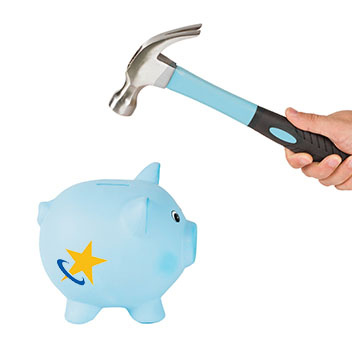Paying off student loans can feel like a heavy burden, especially for teachers. The good news? If you’re an educator, there are specific programs designed to help lighten this load. Federal student loan forgiveness programs for teachers can eliminate a portion or even all your loan balance if you meet the requirements.
Let’s breaks down how loan forgiveness works for teachers, exploring the two most known options available, their eligibility requirements, and how to decide which program is best for you. Plus, we’ll touch on other state-level programs and share repayment strategies to help you make the most of your options.
Teacher Federal Student Loan Forgiveness Options
Teachers have access to two primary federal student loan forgiveness programs:
- Teacher Loan Forgiveness (TLF)
- Public Service Loan Forgiveness (PSLF)
It’s important to know that you can’t “double dip” and count the same period of teaching service toward both programs. However, if you have already received TLF first, that doesn’t mean you can’t qualify for PSLF. You would need to make 120 qualifying payments for a period that was not used to count toward TLF.
What is Teacher Loan Forgiveness (TLF)?
TLF is designed specifically to offer forgiveness for teachers after completing the eligibility requirements of working as a teacher in certain fields, at a low-income school.
Teaching Eligibility Requirements
To qualify for TLF, there are certain criteria you need to meet, which includes:
- You must teach full-time for five consecutive years at a qualifying low-income school or educational service agency. To confirm school or educational service agency, you can check the Teacher Cancellation Low Income Directory.
- At least one of those years must be after the 1997–98 academic year.
Loan Eligibility Requirements
TLF is only available to federal student loan borrowers, however, not all federal student loans are eligible. Here is breakdown of student loan eligibility:
- FFEL or Direct Loans, except FFEL or Direct PLUS Loans.
- You much not have had an outstanding balance on a FFEL or Direct Loan as of Oct. 1, 1998, or on the date you obtain a Direct or FFEL Loan after Oct. 1, 1998.
- Federal Perkins Loans*, a defaulted federal student loan, and private student loans are not eligible.
*Federal Perkins Loans are eligible for teacher’s cancellation offered as part of the Federal Perkins Loan program.
Forgiveness Amounts
TLF offers an opportunity of federal student loan forgiveness up to $17,500. The amount you receive depends on your role, the date you began teaching, if you are a “highly qualified” teacher, and subject area. For example, highly qualified math or special education teachers typically qualify for the maximum $17,500 forgiveness.
Up to $17,500 for a:
- Highly qualified full-time special education teacher for elementary or secondary school children with disabilities.
- Highly qualified full-time mathematics or science teacher for secondary school children.
Up to $5,000 for a:
- Full-time secondary education teacher.
- Full-time secondary education teacher in a subject area relevant to my academic major, if teaching service began before Oct. 30, 2004.
- Highly qualified full-time elementary school teacher.
- Full-time elementary education teacher that demonstrates knowledge in teaching skills in reading, writing mathematics, and other areas of the elementary school curriculum, if teaching service began before Oct. 30, 2004.
What is Public Service Loan Forgiveness (PSLF)?
Public Service Loan Forgiveness (PSLF) offers another pathway to loan forgiveness for teachers, along with other public service workers. PSLF is more flexible because it doesn’t require teachers to work in Title I or low-income schools. However, you have borrower and loan criteria you must meet.
Borrower Eligibility Requirements for PSLF
As a borrower, you must:
- Work full-time, or full-time equivalent meeting a minimum of 30 hours per week, for a qualifying employer or employers, such as a federal, state, local, or tribal government, or a 501(c)(3) nonprofit organization.
- Make 120 qualifying payments under a qualifying repayment plan (that’s 10 years of payments).
Loan Eligibility Requirements
You loans must be:
- Direct Loans
- FFEL and Perkins loans qualify if they are consolidated into a Direct Consolidation Loan, but consolidation may require you to make 120 qualifying payments after the consolidation.
Forgiveness Amount:
Unlike TLF, there’s no cap on the amount forgiven. After 120 qualifying payments while employed full-time by an eligible employer, the remainder of your loan balance is forgiven.
One of the significant benefits of PSLF is its flexibility. It’s available to all teachers, regardless of subject area or school type. Plus, employees in different roles within public service organizations may also qualify.
Benefits of TLF vs. PSLF
Both programs offer distinct advantages depending on your career goals and financial needs.
Why Choose Teacher Loan Forgiveness?
Why you may want to consider TLF:
- Shorter time commitment (5 years vs. 10 years for PSLF).
- Best for highly qualified teachers in specific subjects who have smaller loan debts.
- Ideal if you plan to work in a low-income school and meeting specific service requirements.
- Your loan balance is an amount where you can forgive a significant amount or your total eligible loan balance.
Why Choose Public Service Loan Forgiveness?
Reasons why you may want to consider PSLF?
- No cap on the amount forgiven.
- More flexible teacher requirements. Teachers are not limited to Title I or low-income schools, type of teaching, and no restrictions of when the loan was borrowed or when you began teaching.
- Great for teachers who plan to work in public service for the long term.
State-Level Student Loan Forgiveness Programs
Beyond TLF and PSLF, many states offer additional loan forgiveness programs for teachers. These programs often vary by location and teaching subject but can provide further relief. For example:
- Kansas Bridging Plan – Offers incentives to teachers in rural or underserved areas.
- New York State Teacher Loan Forgiveness – Provides up to $5,000 per year for highly qualified teachers in shortage areas.
- Texas Loan Repayment Assistance Program – Supports educators who teach in high-need fields or at high-risk schools.
Check with your state’s Department of Education to explore available loan forgiveness options in your area.
Federal Perkins Loan Teacher Cancellation
If you have a Federal Perkins Loan, you could be eligible to forgive the loan over five years for qualifying service as a teacher or in education. It’s an incremental forgiveness opportunity which forgives a Perkins loan over five years. The forgiveness increments are:
- 15% for the first year of service.
- 15% for the second year of service.
- 20% for the third year of service.
- 20% for the fourth year of service.
- 30% for the fifth year of service.
Consider an Income-Driven Repayment Plan (IDR)
IDR plans can be a great repayment plan to help you afford your monthly payments. However, these plans do have loan repayment terms which can extend up to 25 years.
Most federal forgiveness programs require qualifying payments under an income-driven repayment plan. Plans like PAYE*, ICR*, or IBR help lower your monthly payment, making it easier to afford while working toward forgiveness.
*As of May 2025, forgiveness offered under ICR, SAVE, and PAYE is on hold pending a legal decision regarding the SAVE Plan. ICR and PAYE can be used as a repayment plan.
Final Thoughts: Maximize Loan Forgiveness Opportunities
Being a teacher comes with unique rewards—but paying off student loans can often feel overwhelming. Thankfully, programs like TLF and PSLF are designed to recognize and reward your service.
Choosing the right program depends on your specific situation. Whether you’re aiming to clear a portion of your loans quickly with TLF or take advantage of the flexibility and higher forgiveness amounts of PSLF, there’s an option tailored to your needs. Make sure you’re informed, stay organized, and take advantage of every opportunity to lighten your financial load.
If you’re ready to take charge of your student loans, start exploring forgiveness options today. Your future (and financial freedom) awaits.







